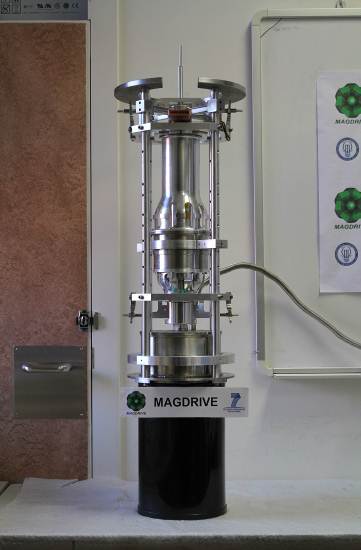January 26, 2015 – Conventional gears require lubricants and wear out over time. What if we could devise mechanisms where the parts don’t touch so that they never wear out?
Well it appears that research being done in Europe on a Magnetic-Superconductor Cryogenic Non-Contact Harmonic Drive, known as the MAGDRIVE, is producing what may prove to be a major advance in machine technology using magnets rather than conventional gears in transmissions. This isn’t an ITER project costing billions and seemingly having no end date in sight. Total cost has been 2.5 million Euros to date.
Industries in a wide range of fields should take note.
The disruptive advantages of this technology include:
- No wear on machine parts.
- No lubricants.
- Operational capability even in the event of a partial failure.
- Operational in extreme environments.
- Little noise and vibration.
How does it work? The secret is integrated superconductor bearings that create stable repulsive forces to keep the gears apart and prevent oscillation, vibration and imbalances. The gears and axles literally float. They never touch. As a result they can spin at very high rates (plus 3,000 rotations per minute). And they can do their work in temperatures as low as -210 Celsius (-346 Fahrenheit) degrees.
Immediate applications include extreme environments such as outer space, but also room temperature applications as well including industries requiring clean room assembly. For NASA and the European Space Agency the technology appears ideal for the onboard machinery necessary to operate future Martian rovers.
For agriculture, land and air transport, energy production (think wind turbines), mining, oil exploration, pharmaceutical, medicine, food preparation, assembly lines, robotics, you name it, this is disruptive technology that can permanently alter the way we humans produce things.
For the latest research results read the journal article entitled, Design and analysis of a non-hysteretic passive magnetic linear bearing for cryogenic environments, published by the Institute of Mechanical Engineers, and written by a team at the Universidad Carlos III de Madrid (UC3M).
One of the inventors, Diez Jimenez, from UC3M states, “the technology is ready to be used in any industrial sector where it is needed.” Just another example of how quickly technological innovation is altering the way we do things in the 21st century.


















I was intrigued when I saw the headline, but reality settled in with the understanding that this required superconductive materials. They would be amazing, but carrying around all that liquid helium to keep things cold enough to function becomes problematic.
There was great work being done a few decades ago on high temperature super conductors, and I haven’t seen much lately. That would be the key to getting this disruptive technology being practical.
Hi Steve, The technology in the MAGDRIVE project does not require the low temperatures of MAGLEV technology. The machinery is expected to provide superconductivity at ambient room temperatures. The big breakthroughs are the versatility in range of environments and the declining cost.
I share your initial skepticism about superconductors that require LHe cooling. In nearly every case where constant power applications are involved, the costs of super conductor material and cooling seems to exceed the benefits. If LN2 cooling temperatures are low enough for a particular superconductor material, costs could probably be cut over 97%. But, as I can understand the basic physics of superconductivity, high currents demand LHe cooling. (MRI resolution is proportional to magnetic field strength, with the most modern machines achieving about 10-Tesla. No known LN2 temperature superconductors can handle the currents needed for MRI) So it’s hard to see how high magnetic field machinery is going to “disrupt” very much except for present methods of wasting money.
Seems likely the ITER project scientists and engineers know nearly everything about superconductivity materials and cooling requirements, yet they have decided that the main solenoid coil is to be made of niobium-tin and to carry the 46 kA needed for plasma confinement must be cooled with LHe to 4.5 Kelvin. (To reduce radiation transfer, the LHe blanket is surrounded by a LN2 blanket.) Truth is, LHe cooled superconductor power systems will probably never be economical on the Earth’s surface. The ITER project is already 3-times over its extravagant budget and 11-years behind schedule.
However, background radiation equilibrium of interstellar space is near 2.7 Kelvin. So, in principle, when confined He gas is shielded from direct solar radiation it will naturally fall to 2.7 Kelvin, condense, and liquefy. LHe cooled superconductor power systems will likely prove practical in deep space. Space-faring mankind may eventually find endless free LH2 and LHe on Oort Cloud objects. Implications to distant future interstellar habitats/ships are huge. Superconductor magnetic plasma confinement for nearly perpetual fusion power might someday find a place in deep space.